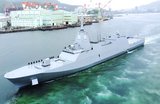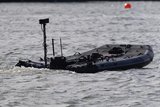UK government defends nuclear submarine fleet after missile misfire
A test firing of a Trident missile from a UK Royal Navy Vanguard SSBN in 2012. A similar firing on 30 January 2024 failed. (Photo: Lockheed Martin)
A UK Royal Navy test-firing of Trident II D5 ballistic missile on 30 January from HMS Vanguard SSBN experienced “an anomaly”, according to UK secretary of state for defence Grant Shapps, “without wider implications” despite a previous missile firing failure in 2016.
Last month’s test launch was part of a Demonstration and Shakedown Operation which assessed the performance of the submarine and its crew, culminating in an unarmed firing.
“On this occasion, an anomaly did occur, but it was event specific and there are no implications for the reliability of the wider Trident missile systems and stockpiles…nor are there
Already have an account? Log in
Want to keep reading this article?
More from Naval Warfare
-
![Hanwha wins Australian government approval to increase its stake in Austal]()
Hanwha wins Australian government approval to increase its stake in Austal
The contract would mean the two shipbuilders can collaborate strategically and enhance shipbuilding capabilities in Western Australia.
-
![US Navy seeks new sensors for the CH-53K King Stallion heavy-lift helicopter]()
US Navy seeks new sensors for the CH-53K King Stallion heavy-lift helicopter
The US Navy intends to publish a draft request for proposals in Q2 2026 and conduct an open competition for the supply of new electro-optical and infrared capabilities for the CH-53K heavy-lift helicopter.
-
![What new technologies could be involved in UK Atlantic Bastion initiative?]()
What new technologies could be involved in UK Atlantic Bastion initiative?
As new details emerge on the UK Royal Navy’s plan to secure the North Atlantic for the UK and NATO, three main areas of opportunity for new technology are the focal point.
-
![NATO naval exercises map out future USV requirements but raise questions on acquisition]()
NATO naval exercises map out future USV requirements but raise questions on acquisition
Uncrewed surface vessels have shifted from a desirable capability to a critical one for navies. But should these systems be bought outright, rented as a service or rapidly built using commercial off-the-shelf components?






















